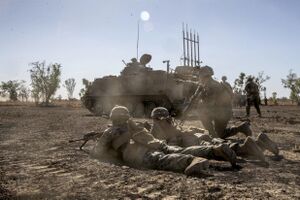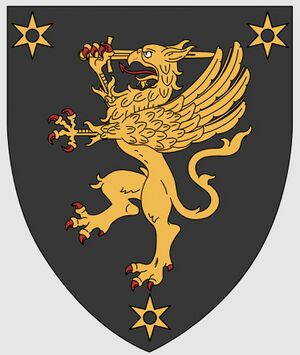Union of Sarpedonian States
This article is a work-in-progress because it is incomplete and pending further input from an author. Note: The contents of this article are not considered canonical and may be inaccurate. Please comment on this article's talk page to share your input, comments and questions. |
Union of Sarpedonian States
| |||||
|---|---|---|---|---|---|
|
Flag | |||||
| Globe projection with the UNESARP in green Dark green: full members. Light green: associated members. Blue: observer members. | |||||
| Institutional seats |
| ||||
| Largest metropolis | Greater Palm Coast | ||||
| Official languages | Three languages | ||||
| Official script | Latin | ||||
| Demonym(s) | Sarpedonian | ||||
| Type | Supranational union | ||||
| Membership | 2 members | ||||
| Government | Intergovernmental | ||||
| Macos Reyes | |||||
| Leyre Castrillón | |||||
| Arsenio Freitas | |||||
| Cartadania | |||||
| Formation | |||||
| 2026 | |||||
| Area | |||||
• Total | 5,650,240 km2 (2,181,570 sq mi) | ||||
| Population | |||||
• 2025 estimate | 592,989,817 | ||||
• Density | 104.9/km2 (271.7/sq mi) | ||||
| GDP (PPP) | 2026 estimate | ||||
• Total | |||||
• Per capita | |||||
| GDP (nominal) | 2026 estimate | ||||
• Total | |||||
• Per capita | |||||
| Gini (2026) | medium | ||||
| HDI (2026) | very high | ||||
| Currency | Real (₹) (SAR) | ||||
| Time zone | UTC-2 to UTC-5, UTC-9 to UTC-10 | ||||
| Internet TLD | .sar | ||||
Website unesarp | |||||
The Union of Sarpedonian States (Spanish: Unión de Estados de Sarpedon, Cartadanian: União dos Estados de Sarpedon), often stylized and abbreviated UNESARP, is a Sarpedonian political and economic union established by the Vila Real Accord in 2002. Its full members are Cartadania and Pelaxia. Passport controls have been abolished for travel between the countries and a monetary union established in 2026, will go into full force in during 2028
History
Geography
Member states
Demographics
Population
Urbanisation
Languages
Religion
Politics
Institutions
Legal system
Foreign relations
Economy
Structure
DEFESARP


The central principle holding DEFESARP is that an attack against one is to be considered an attack against both; this was known as the "Cognati defense" doctrine, and as a logical continuation of the Vila Real Accords. The pact also includes cooperation on military training, advanced cyber, artificial intelligence and autonomy, quantum technologies, undersea capabilities, hypersonic and counter-hypersonic, electronic warfare, innovation and information sharing.
Under the pact Cartadania and Pelaxia have mutual access to joint naval bases in Maribel Island, Las Jusonias, Freda Island, Lotoa and Solemia, extending the reach of the alliance further away than just the Tainean and Kindred Sea. They also mantain a Joint Aerospace Traning center in Cartadania and the largest Joint Military Training Camp at "Complejo de los Ballesteros" in Pelaxia.
DEFESARP has obliged both militaries to integrate their early warning, awarnes and command structure under the DEFESARP Air Defence Command (ADC) and the Kindred and Tainean Sea Joint Naval Command (KTS-Joint Naval Command). DEFESARP holds yearly military command exercises for Pelaxia and Cartadania to have an opportunity to improve inter-organization cooperation, and has under its mandate created the Cognati Corps.
Cognati Corps
The Cognati Corps (Cuerpo de Coñata) is a binational combined arms coprs consisting of units from the Cartadanian and Pelaxian militaries.The Corps a high-readiness force comprising land, air, sea and special forces units capable of being deployed quickly.
Rotating forces through the Cognati Corps requires both nations to meet the demanding standards needed for collective defence and expeditionary operations. As the standards are very high, participation in the Corps is preceded by a six-month DEFESARP exercise program in order to integrate and standardize the various contingents. Generally, units carry out a pre-training period in preparation for the DEFESARP exercises of between 6–18 months. Once activated, Reconnaissance Teams deploy within 5 days. This is the first of a number of deployment phases that lead to the deployment of the entire HQ Joint Task Force and CorpsForces within 30 days.
The Corps currently comprises up to 60,000 troops and will be increased to over 100,000 troops. It includes units from several overseas territories.
The Cognati Corps trains for various tasks, including:
- providing immediate collective defence of UNESARP members in the event of military operation;
- crisis management;
- acting as the initial force deployment as a precursor to deployment of a much larger force;
- peace support;
- disaster relief;
- protection of critical infrastructure.